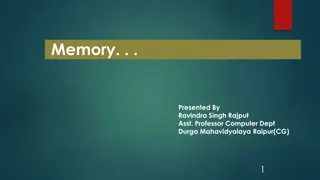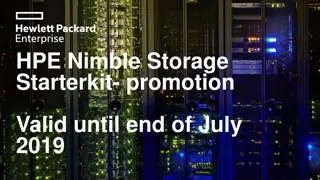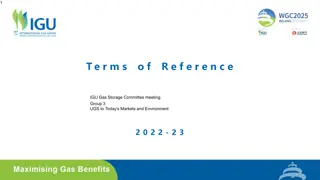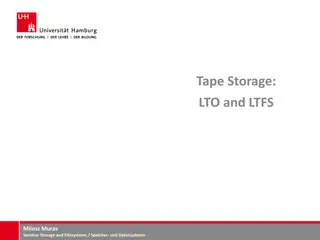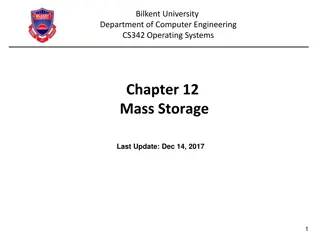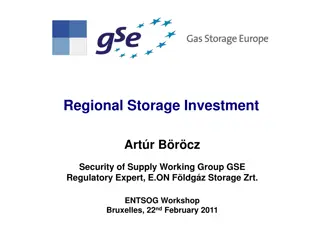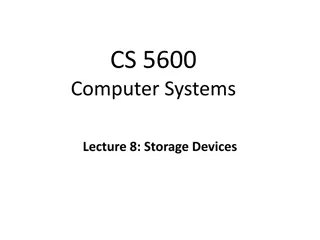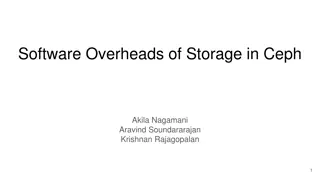Understanding Computer Data Storage with Ceph
Delve into the world of computer data storage through an exploration of block storage, file storage, and object storage. Learn about the APIs, protocols, and examples associated with Ceph, a distributed data storage solution. Understand the nuances of physical data storage devices, filesystems, and the layers that culminate in the block layer within data storage architectures.
Download Presentation

Please find below an Image/Link to download the presentation.
The content on the website is provided AS IS for your information and personal use only. It may not be sold, licensed, or shared on other websites without obtaining consent from the author. Download presentation by click this link. If you encounter any issues during the download, it is possible that the publisher has removed the file from their server.
E N D
Presentation Transcript
CEPH Introduction: means of computer data storage
Introduction: means of computer data storage API used for storing computer data Block storage File storage Object storage
Introduction: means of computer data storage Block storage: Block read/write 0. block 1. block 2. block 3. block 4. block 5. block Blocksize (eg. 512b, 4KB) Examples: Most of physical data storage devices HDD, SSD, pendrive SCSI, SATA, usb mass storage protocols are all block based LBA scheme nowadays instead of a CHS Logical block devices made out of physical data storage devices Hardware/software RAID (pl. Linux md devices) Linux device mapper (/dev/dm-* devices) LVM Encrypted disks (dm-crypt) Also zvol (block device made out of a ZFS dataset) Examples: Variants of physical data storage device protocols that work over IP/Ethernet eg. iSCSI Block API protocols of distributed data storage solutions CEPH RBD (RADOS block device)
Introduction: means of computer data storage File storage: F jl open, close, write, read, create, delete Examples: Filesystems Block, file, object storage are often built on each other Basic filesystems are based on block But in case of ZFS an object layer is placed between the file and block layer: block -> object -> file ZFS zvol: Block -> object -> block Ext4, xfs, ntfs, fat, zfs, btrfs IP based file access SMB, NFS, WebDAV File API of distributed data storage solutions cephFS, glusterfs A lot of layers until we reach the block layer
Introduction: means of computer data storage Object storage: Unstructured data In general object name is only a UUID Flat namespace Metadata is key To be able to search in the data Metadata is indexed, object storage is optimized for searching based on metadata Eg. Searching pictures based on various properties Background=blue, isThereAHuman=true, creationYear=2021 stb. Example: AWS S3 API, OpenStack swift There are API-s, lots of implementations S3-at is also provided by Amazon as a service Most cloud storage solutions also use this in the backgroud Google Drive (format of share links) Object API of distributed data storage solutions CEPH librados, RGW (S3/swift) ZFS uses it internally, but it s not accessible directly
CEPH CEPH
CEPH Distributed data storage solution Free/open source Runs on normal PC/server machines Open source alternative of vendor made, turnkey solutions 4 API types Object: Librados Object: RGW Block: RBD File: CEPH FS
CEPH Daemons: Physical view host1 host2 OSD.1 OSD.0 OSD.5 OSD.4 OSD.2 OSD.3 MGR MON MGR host3 CLIENT MGR MON CLIENT
CEPH Daemons: Logical view Every daemon talks with each other Those on the same host on loopback Host boundaries have no role besides optimalisation CEPH cluster OSD.1 OSD.0 OSD.5 OSD.4 OSD.2 OSD.3 MGR Daemon types MON: monitor Central config MGR: manager OSD: object storage daemon 1 disk+cache 1 OSD CLIENT: CEPH client Administration, data storage MON MGR CLIENT CLIENT MGR MON
CEPH Data storage RADOS object: Every daemon talks with each other No central node The monitor only provides cluster information CEPH cluster OSD.1 OSD.0 OSD.5 OSD.4 OSD.2 OSD.3 MGR MON MGR CLIENT CLIENT MGR MON
CEPH Redundancy: Replication Erasure coding CEPH cluster OSD.1 OSD.0 OSD.5 OSD.4 OSD.2 OSD.3 MGR MON MGR CLIENT EC blocks Original object CLIENT MGR MON
CEPH CEPH cluster RBD: Image file striped into multiple object client- side RGW: S3/swift object striped into multiple objects by RGW daemons OSD.1 OSD.0 OSD.5 OSD.4 OSD.2 OSD.3 MGR MON MGR CLIENT CLIENT MGR MON
CEPH CEPH cluster iSCSI GW: CEPH client iSCSI target OSD.1 OSD.0 OSD.5 OSD.4 OSD.2 OSD.3 MGR MON MGR iSCSI GW iSCSI iSCSI GW iSCSI iSCSI initator MGR MON


